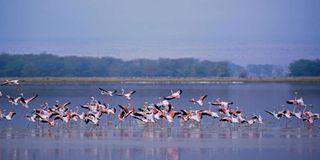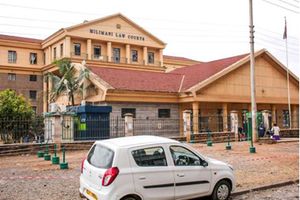Premium
‘Flamingo home’ turns pink with the birds’ return

With more than 1.4 million birds on its shores, the lake made its name globally as the home of flamingos.
What you need to know:
- Lake Nakuru was a spectacle of beauty six years ago.
- With more than 1.4 million birds on its shores, the lake made its name globally as the home of flamingos.
- In addition to the flamingos, more than 400 bird species were found at the lake, earning it the title “a bird watchers’ paradise”.
Lake Nakuru is pink again. From a desolate and forlorn water mass in recent years, flocks of flamingos can be seen from afar flocking the national park.
In the words of the American modernist artist Charley Harpert, the lake is once again the arena of “pure, passionate, pink pandemonium – a frenetic flamingle-mangle – a discordant discotheque of delirious dancing, flamboyant feathers and flamingo lingo”.
The last flock, which started flying away in 2014, left the lake in 2018 due to what experts attribute to pollution and rising water levels.
The anchor attraction at the national park — the massive migration — took a toll on tourism, affecting associated businesses in Nakuru, Naivasha, Elementaita and other neighbouring regions.
“Since flamingos are the main selling point for the park, it became a challenge to convince visitors to come without having to see the birds. Some cancelled their trips on getting news of the migration,” senior warden Collins Ochieng said.
In the past week, dozens of flamingos have been flying back to the lake.
They are accompanied by pelicans and other bird species.
Lake Nakuru was a spectacle of beauty six years ago.
With more than 1.4 million birds on its shores, the lake made its name globally as the home of flamingos.
In addition to the flamingos, more than 400 bird species were found at the lake, earning it the title “a bird watchers’ paradise”.
Mr Ochieng also attributes their comeback to the flooding of other lakes the flamingos had migrated and a lot of food on the shores of Lake Nakuru.
Despite rising water levels, algae have grown on the new shores.
Climate change
Lake Nakuru has been experiencing a gradual rise in water levels due to climatic change and pollution from the estates and factories.
Flooded lake shores stopped the growth of algae, the main food for the flamingos, making them move to other areas.
A majority of the flamingos moved to Lakes Bogoria, Natron and Turkana.
In 2018, Lake Bogoria received at least 1.3 million flamingos, a good number having flown from Lake Nakuru.
Authorities are in a rush to improve tourism in the park by repairing infrastructure.
This includes constructing roads and moving offices that had been drowned by the lake.
The management has also reduced entry charges for domestic and international tourists.
This is expected to attract more visitors at a time the world is battling the Covid-19 pandemic.
Economies around the globe have been hit hard by the effects of the pandemic.
Hotel owners at the park are excited with the return of the migratory birds.
Lake Nakuru Lodge director Joseph Muya yesterday exuded confidence that the number of local and foreign tourists would increase.
“We are happy that Lake Nakuru is slowly reclaiming its glory as bird’s paradise,” Mr Muya told the Nation.
“Flamingos are the owners of this lake. Seeing them return in their thousands rekindles hope that the good times are almost back.”
Mr Muya added that the pandemic destroyed the business environment.
“We hope to recover, especially after the government opened the country’s airspace. There is optimism that visitors from abroad will begin flocking to the park,” he said.
Apart from the birds, Lake Nakuru National Park plays host to the big four alongside several species of giraffe.
It has other attractive points like the Makalia Falls and the Baboon Cliff.





